Cruising to Antarctica: My Review of the National Geographic Explorer
When cruising Antarctica, the smaller the ship, the more you will get to experience and do.
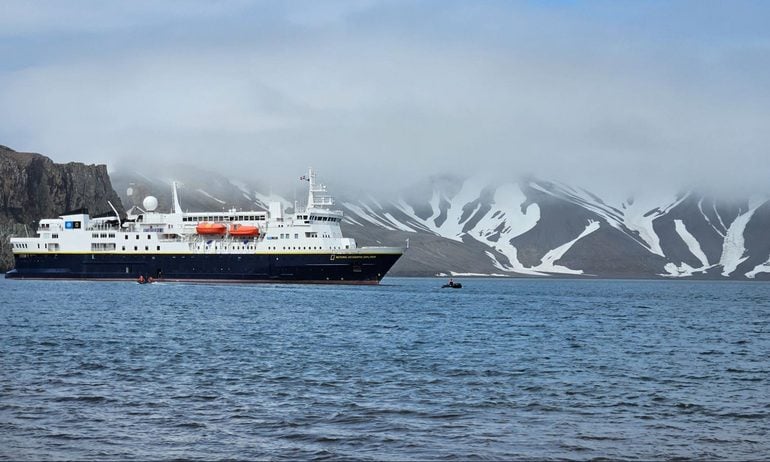
Many or all of the products on this page are from partners who compensate us when you click to or take an action on their website, but this does not influence our evaluations or ratings. Our opinions are our own.
For years, the bottom of the world was on the top of my travel list. So when I saw a new itinerary option for an adventure to Antarctica on the National Geographic Explorer, I signed up right away, eager to finally join “the seven continents club.”
The word “incredible” accurately describes my experience.
I went to the bottom of the world in December 2024. The 10-day cruise was part of a longer three-week South American trip that took me to Argentina, Antarctica and three places in Chile, including the remote Easter Island, home of the huge Moai statues.
Those statues, the stunning icebergs, the penguins and the friends I made all turned it into an outstanding adventure.
In this review
Booking process
The National Geographic Explorer is part of a co-brand called National Geographic-Lindblad Expeditions.
The two companies have been partners in expedition cruising for more than 20 years. Lindblad has a fleet of 20 ships, and National Geographic has a mission of using “the power of science, exploration, education and storytelling to illuminate and protect the wonder of the world.”
I had been thinking about taking a trip to Antarctica for several years, but what interested me the most was a new sail and fly option with National Geographic-Lindblad where I could board the ship, sail across the notoriously rough Drake Passage once and then take a two-hour flight back from Antarctica to South America.
Many other expeditions sail through the Drake in both directions, adding two days to the trip as well as some anxiety about the possibility of rough seas twice.
A trip to Antarctica is not cheap. Pricing begins at about $12,000 per person, based on cabin category. Because of the cost, I did my research on different cruise companies before deciding to book.
I booked my trip through the alumni association travel program of my alma mater, Duke University, but most of the paperwork after that came from Lindblad.
I have to say, I was underwhelmed with the communication before the cruise. It was a bit confusing, and sometimes an email said a detail was included in an attachment when it wasn’t.
I also needed to rent some gear and was unclear about exactly what I needed to rent and what was provided. After poking around on the website for the rental partner Ship to Shore Traveler, I gave up and called someone at Lindblad and found out I 100% needed to rent waterproof boots.
Nat Geo/Lindblad provides both a parka and insulated jacket to every guest, which will be waiting in your cabin when you embark. To make sure they have sizes for everyone, you need to order your parka before your cruise. But don’t panic: They have plenty of extras on board in case yours doesn’t fit quite right.
That seemed to be a recurring theme with me and some of my fellow travelers: Try to find the information yourself online or in the documents they sent and then, once frustrated, call Lindblad and get the answer. Often, each of us in my group would call to make sure we got the same answer.
I had the feeling that once I got on board, everything would be great as far as communication was concerned, and I was right.
» Learn more: The best travel credit cards right now
Embarkation
I needed to get myself to Ushuaia, Argentina, to board the ship and then from Puerto Natales, Chile, after the expedition.
Even though Nat Geo/Lindblad has an air department, I booked all of my own flight arrangements because I wanted to use American Express Membership Rewards points and a Delta Air Lines certificate I had.
I flew through Buenos Aires, Argentina, and then on to Ushuaia, where the expedition officially began with an included transfer from the airport to our group hotel.
The hotel was an extension of the ship in a way, with a hospitality desk and a group orientation dinner.
The next morning, everyone got on buses for a tour that would end at the pier so we could get on the ship.
The ship
The National Geographic Explorer is a small ship at only 367 feet long and 54 feet wide with six passenger decks and 81 cabins to hold 148 passengers.
The number of passengers on an Antarctic ship makes a huge difference in the kind of experience guests have. Ships carrying more than 500 passengers cannot make landings in Antarctica, so the experience will be just a drive-by, so to speak. There are strict regulations for ships carrying 201-500 passengers, so the sweet spot is ships with fewer than 200 passengers if you want to go ashore.
When it isn’t in Antarctica, the Explorer goes to other destinations like Iceland and the Canadian Maritimes.
The ship is designed for expeditions with stabilizers and an ice-reinforced hull. I admit, when I first saw it, I was a bit nervous about its size since I was used to much bigger ships.
My fears turned out to be unfounded because the Explorer had everything we needed.
The cabin
Nat Geo-Lindblad acknowledges the fact that some people might be traveling alone and do not want to pay double for the privilege of doing so. It offers 14 solo cabins and, on the Explorer, they are on two decks.
I chose one: Cabin 333, a Category A cabin on the main deck.
The cabin felt fairly spacious with a large window with room darkening coverings, which were very important for an itinerary like this one where the sun really doesn’t set.
A twin bed was against one wall with a built-in nightstand next to it. One strange thing was the plug and USB outlet directly above the pillow.
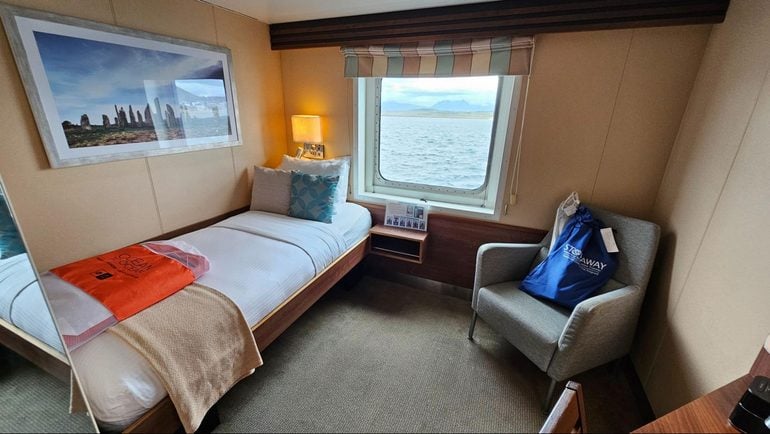
(Photo by Tiffani Sherman)
A chair was near the bed, which became my gear storage and staging area.
There was a nice desk space with several plugs and a word atlas under glass as decoration. On this trip, it was conveniently open to the Antarctica page.
In addition to shelves on the edge of the desk and under the TV, there were two shelves with pull-out bins on the side.
The closet also had plenty of storage.
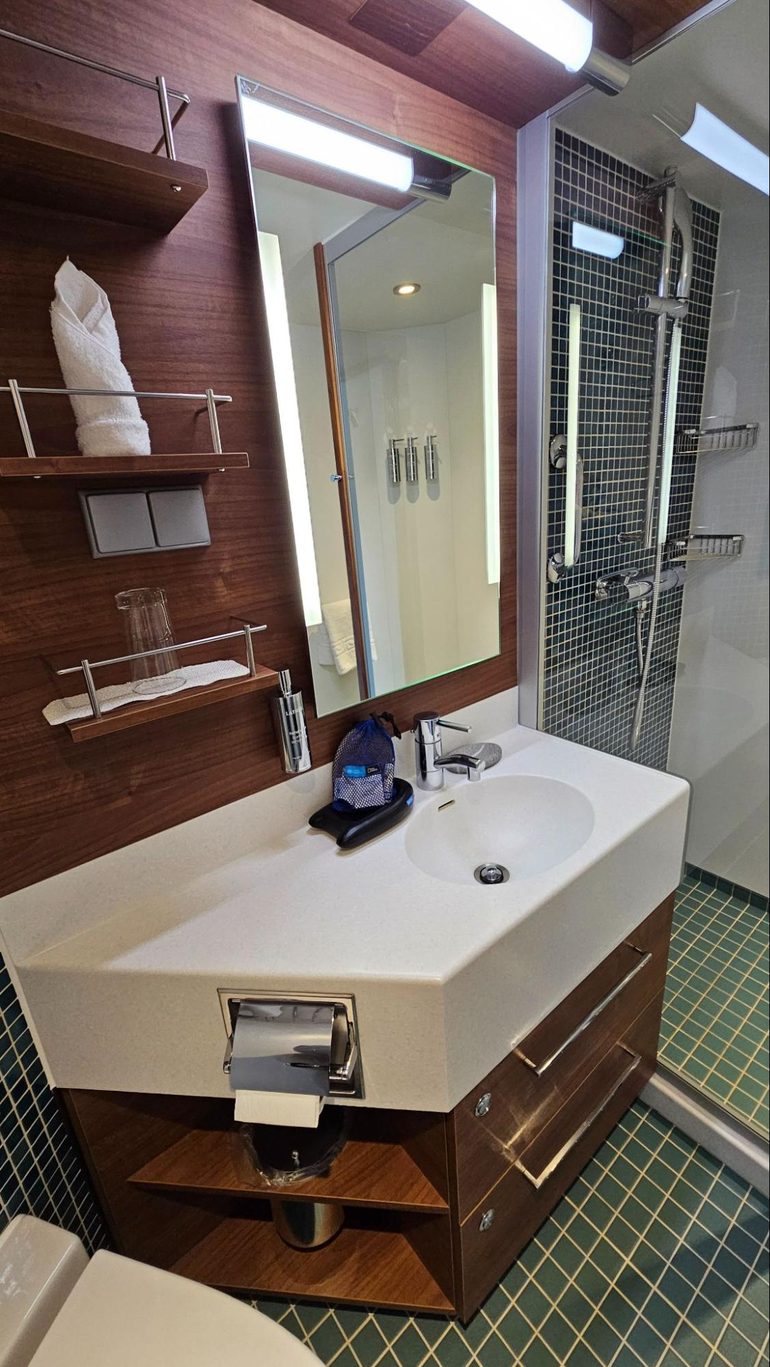
The small bathroom felt spacious. (Photo by Tiffani Sherman)
The bathroom felt spacious with a walk-in shower and a large sink vanity area with storage next to it and drawers under it.
Since the Explorer is an expedition ship designed to handle rough seas, all of the drawers and cabinets have latches on them, just in case.
Ship amenities
My cabin location turned out to be perfect, with cabins making up the entire deck and other ship amenities both above and below. There were three staircases and one elevator.
Immediately out of my cabin and down one flight of stairs was the area the expedition leaders called base camp. It was the boarding area for all of the excursions on Zodiacs (sturdy inflatable boats), as well as a storage area with cubbies for things you didn’t want to bring back up to your cabin, like boots, gloves, hats, etc.
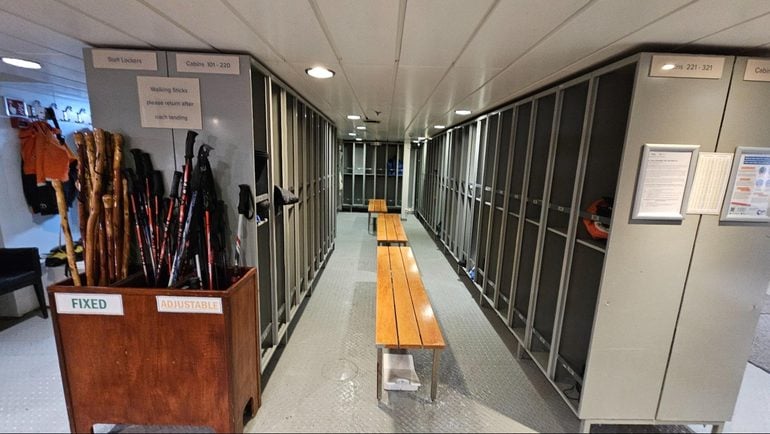
Every cabin had a storage area. (Photo by Tiffani Sherman)
One level up from my cabin was the upper deck, which had more cabins and many important amenities. The reception deck was here just across from the shop. I was hoping to find an Antarctica magnet in the gift shop, but it didn’t have any.
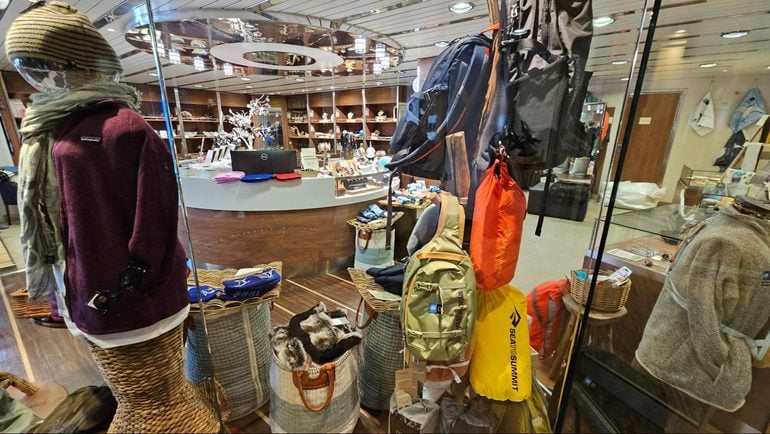
The store had many cool branded items and high-end goods but no cheesy souvenirs. (Photo by Tiffani Sherman)
The bistro, with its coffee and tea options as well as really yummy cookies, was just behind reception.
Some dining tables were across from the bistro, and the restaurant was further up toward the bow. There was plenty of open seating, but we quickly learned the tables were all bolted down and the chairs were tethered, so there was no pulling up a chair to join a table.
Breakfast and lunch were served buffet style, with a few additional options available on a menu. Dinner was table service with options that changed daily.
All of the naturalists and scientists dined and mingled with the guests at mealtime, which was really cool.

Lunch salad bar. (Photo by Tiffani Sherman)
Above the upper deck was the veranda deck, which had a few cabins along with two main areas, the lounge and the chart room.
I spent a lot of time in the lounge area since it was where all lectures and briefings happened. The expedition leaders called the center area the “circle of truth” because it was where the speakers stood during their presentations with their technology. Television monitors were all over the lounge to use for visuals during presentations or lectures.
More on those experiences later since they are a huge part of a Nat Geo/Lindblad expedition.
There was also a bar that opened every evening for drinks, many of which were included. A huge sun deck was off the lounge, but it was usually too cold to be out there, unless you were a smoker. That was the only smoking area on the ship.
The chart room was on the same deck in the bow area and was the place with 24-hour coffee, tea, other nonalcoholic drinks and a few snacks. There was also access to the bow from here, which was usually open.
The wellness deck is basically a storage area for lifeboats, Zodiacs and kayaks. The aft part of the deck has the fitness center, spa and sauna.
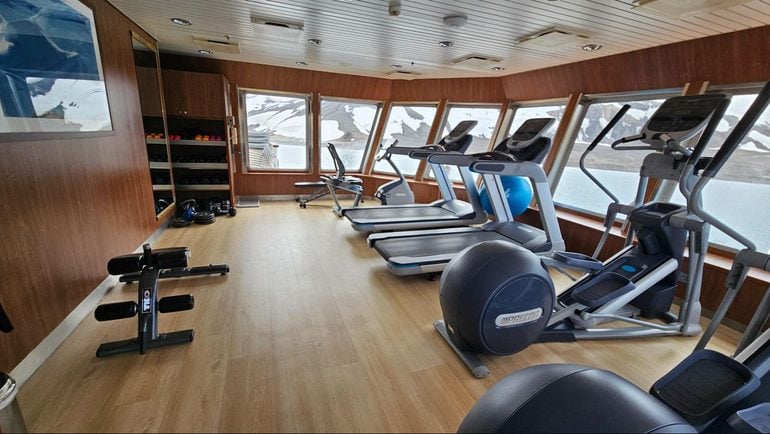
(Photo by Tiffani Sherman)
The view from the fitness equipment was great, but I admit I never used it during my cruise.
Massages were available in the spa for an additional fee.
The top deck was the bridge deck and creatively had the bridge in the front. The bridge has an open-door policy, so guests can go in at any time. I went in during a blinding snowstorm, and it was really cool to see how all of the navigation equipment and the crew kept everyone safe.
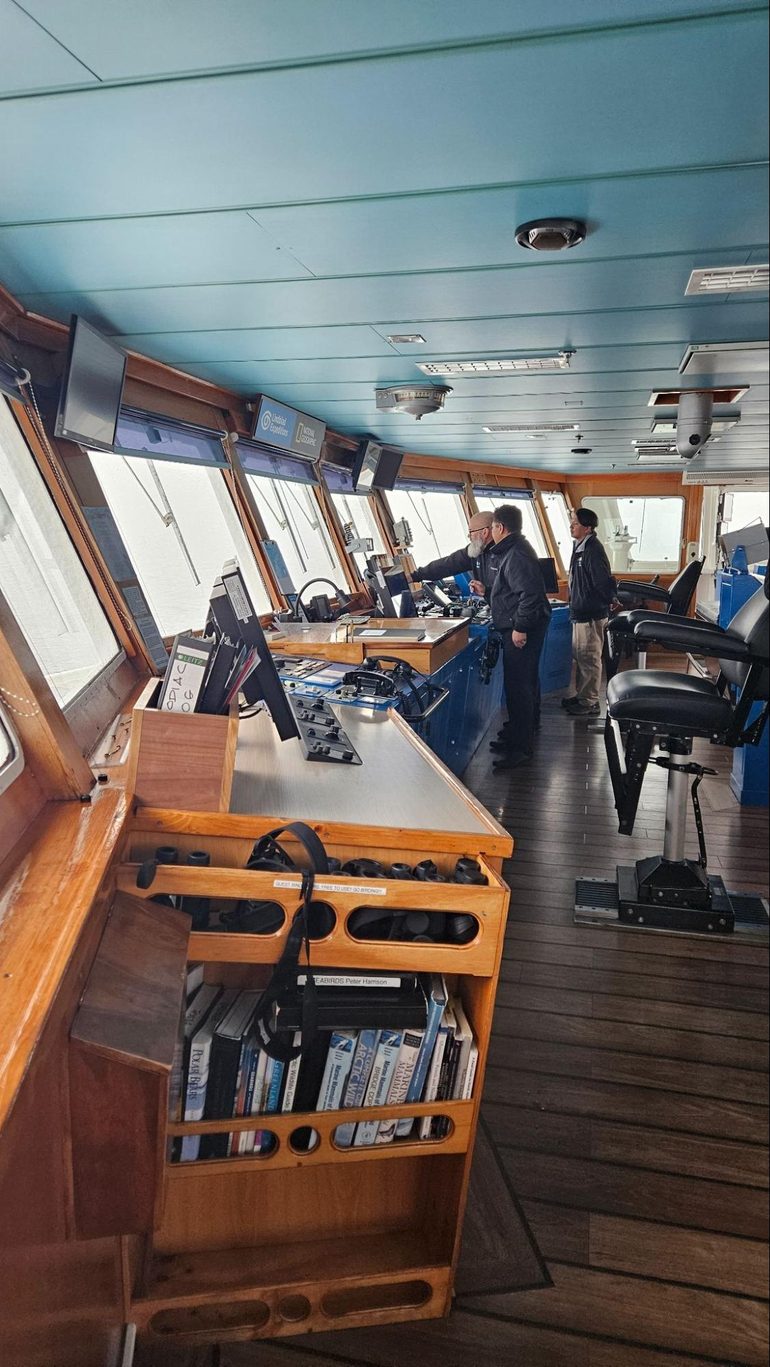
(Photo by Tiffani Sherman)
The rest of the bridge deck is divided between the library and observation lounge. It was a great and warm place with huge windows to watch the scenery go by as we moved throughout Antarctica. There were also many books both for enjoyment and for research about what we were seeing.
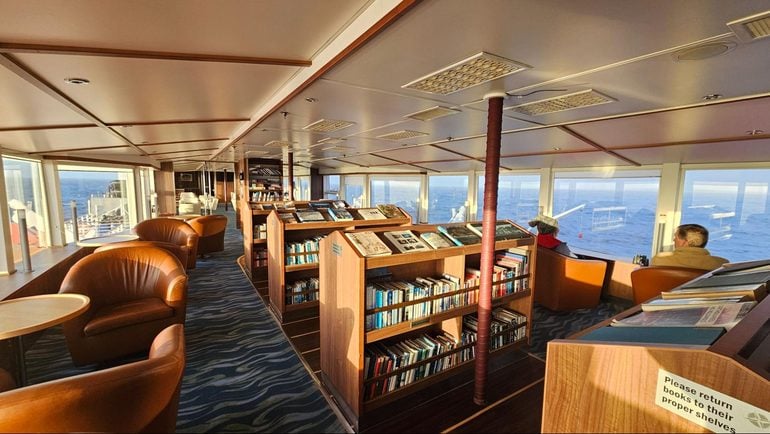
(Photo by Tiffani Sherman)
Crew members also served a light lunch in the observation lounge, which was perfect for people who didn’t want to leave the scenic views behind to head to the restaurant.
» Learn more: The best cruise lines
Communications and Wi-Fi
Even though I was in the middle of nowhere, I wanted to stay in touch with family and friends back home, and that meant having internet access.
Onboard Wi-Fi was free but limited in bandwidth. It was possible to check email, send messages, browse a few websites and look at social media.
I chose to upgrade to the $25-per-day (or $150-per-voyage) enhanced Wi-Fi plan, which allowed me to download and upload photos as well as browse just about anything.
The $50-per-day (or $300-per-voyage plan) would have allowed streaming, but I didn’t need that capability.
The expedition leader communicated with guests using a speaker system that was in all public areas as well as in the cabins. Each morning, it was like a calm voice waking us up and telling us about the updated plan for the day. Crew members would also announce wildlife or scenic sightings along the way.
Televisions in the cabins and a web portal also had the daily schedule and navigational information.
The itinerary
My cruise was a 10-day itinerary, which included time for embarkation, crossing the Drake Passage, a few days exploring Antarctica and then the flight back to South America.
Since the weather is unpredictable and there are many rules and regulations ships need to follow, we needed to learn about the guidelines.
The expedition leader (which is like a cruise director on other cruises) led a staff of 16 people, all of whom had impressive credentials like doctorates in various marine subjects as well as extensive experience on expedition ships. One naturalist told me people don’t apply to work for the company; the company finds who it wants and goes about getting them.
During the time we were crossing the Drake Passage, we learned about the International Association of Antarctica Tour Operators (IAATO), and how it works “to practice and promote safe and environmentally responsible travel to this remote and delicate region of the world.”
We learned how to clean our boots and poles, why it’s important to not put anything on the ground, what we needed to wear for each excursion and how to get on and off the Zodiacs safely and without falling in the water. To be allowed off the ship, we had to sign a pledge to respect the rules and regulations.

Our expedition leader gives a briefing in the “circle of truth.” (Photo by Tiffani Sherman)
The excursions
The general plan is for two excursions off the ship each day, one in the morning and another in the afternoon. But as we learned, weather and wildlife can quickly change the plans.
One day we had to cancel our morning outing because of winds and heavy snow, only to find ourselves in an area with a large pod of humpback whales.
On the other days, we had our two excursions. Sometimes we were able to take the Zodiacs to land and walk around. Other times we stayed on the Zodiacs for about 90 minutes to look at incredible ice and wildlife.
Each Zodiac was a sturdy inflatable boat that could be raised and lowered to the waterline from a storage area on a top deck and had an experienced guide/driver who was in constant communication with the ship and other Zodiacs. They’d exchange information about the conditions and wildlife they were seeing.
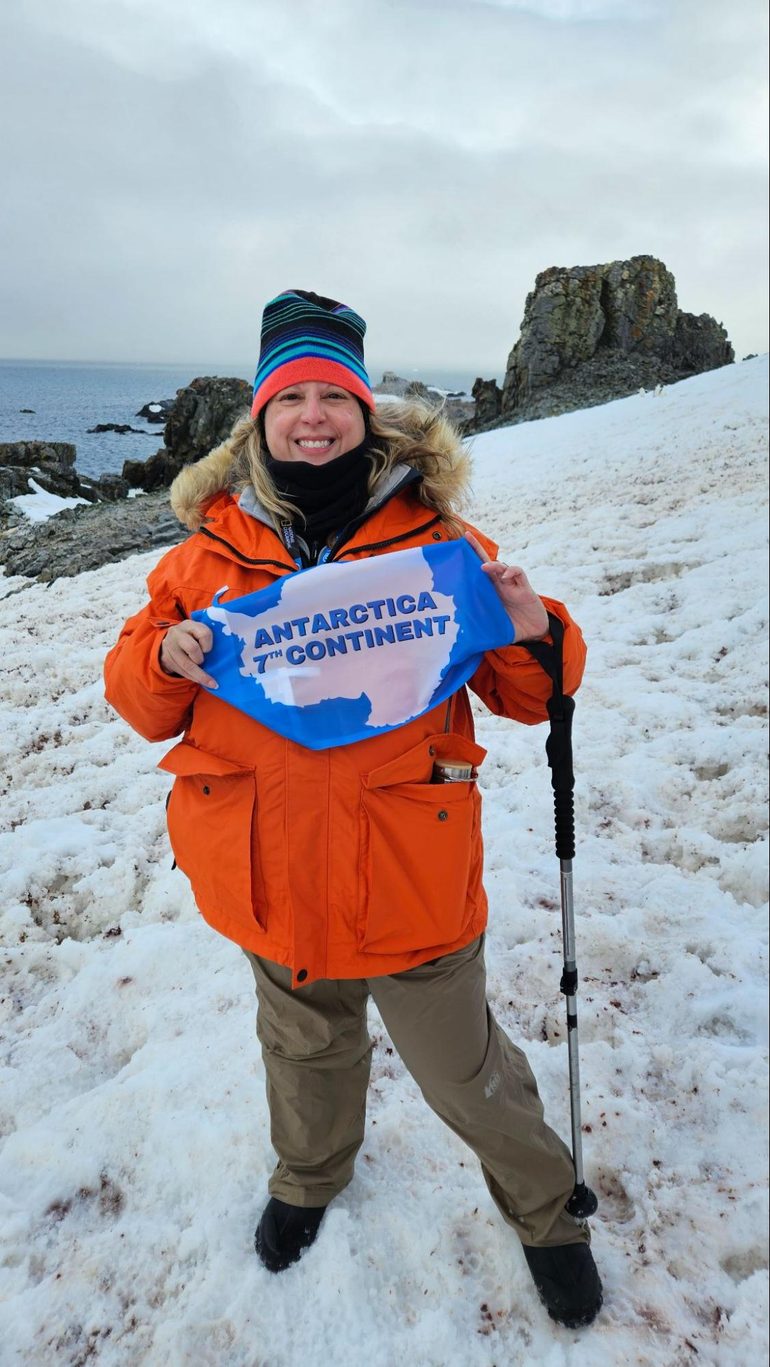
I became an official member of “the seven continents club.” (Photo by Tiffani Sherman)
Getting off and on the ship was an organized process. Everyone on the ship was divided into one of six groups based on traveling companions or by cabin. For example, our entire 22-member group from Duke was in group D.
Only three groups could be ashore at a time since IAATO regulations limit the number of visitors ashore at any time to 100 and there must be a specified number of staff members with passengers.
The base camp manager would announce which groups could go ashore and in which order, which changed for each excursion so no one group would always be first or last.
When we were not off the ship exploring, a naturalist or visiting professor lecturer (on my trip there were four) was usually presenting in the lounge. Sometimes the same lecture happened twice because half the guests were off the ship at a time, so those on board listened to the lecture. When the others came back on board, the groups switched.
I quickly discovered traveling with Nat Geo/Lindblad is all about learning the most information possible about Antarctica. It isn’t about relaxing and downtime. I can’t imagine taking a cruise to Antarctica on a big ship and just sailing past the beautiful scenery and not being able to get off the ship and explore.
That’s the benefit of a small expedition ship.
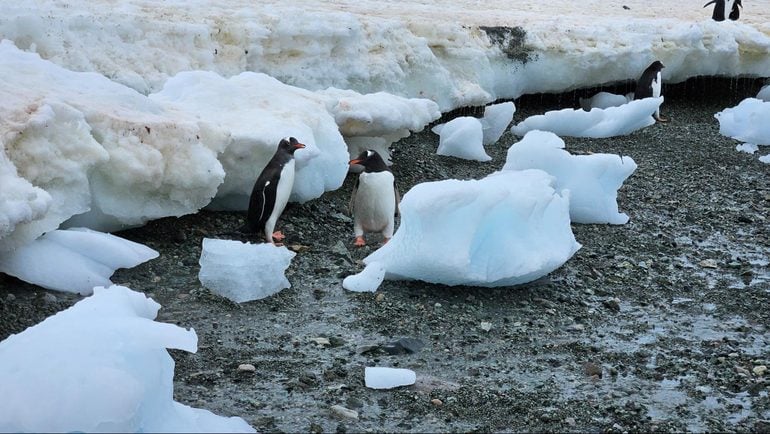
There were so many gentoo penguins everywhere. We had to stay at least 15 feet away from any wildlife. (Photo by Tiffani Sherman)
Every evening before dinner, we had a recap briefing in the lounge, usually with a cocktail in hand. During that time, we'd learn more about an animal or bird we saw that day, discover the complexity of icebergs or look at footage the ship’s two divers took when they went under the water while the guests were either on land watching penguins or zooming about in Zodiacs.
During the trip, we ended up making four landings and taking three extended Zodiac cruises. We saw gentoo and chinstrap penguins, humpback whales, leopard seals, Weddell seals and many types of birds on and around amazing icebergs and ice formations.
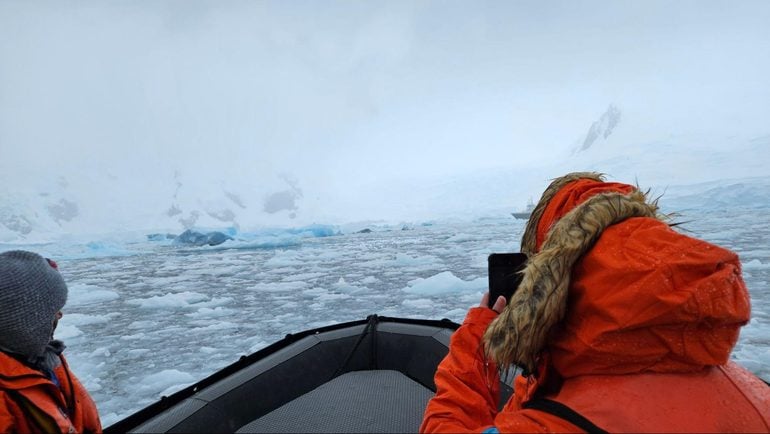
(Photo by Tiffani Sherman)
Everything was a logistical challenge for crew members, and they handled it without a hitch.
Disembarkation
After eight nights on the ship, it was time to disembark. Because this was a sail and fly itinerary, the disembarkation process for this cruise was nothing like it had been on the dozens of other cruises I have been on.
All of the passengers and their luggage still needed to get off the ship so others could board, but the process was very different.
We were anchored off King George Island in the South Shetland Islands. On land, there is a small research station and a small airport terminal near a gravel landing strip.
But there is no dock for a ship, so everything in the disembarkation process had to happen via Zodiac.
Like with other cruises, we had to put our luggage outside our cabins so crew members could take it off the ship and get it to shore. We kept our carry-on luggage with us.
A charter airline operates flights in and out of the airstrip, and the weather can impact if the planes can land or take off. There were two planes scheduled, each taking half of the passengers.
We waited on board the ship until the first plane landed. Then we put on all our waterproof clothing and parkas one more time for a Zodiac trip to the shore with our carry-on luggage. It was quite an experience.
One thing we thought was weird was the fact we didn’t have to scan our keycards on the way out since I know that’s one way cruise lines know passengers are off the ship. I guess they could count us easily enough as we boarded the Zodiacs. The problem would be knowing who was missing if someone was.
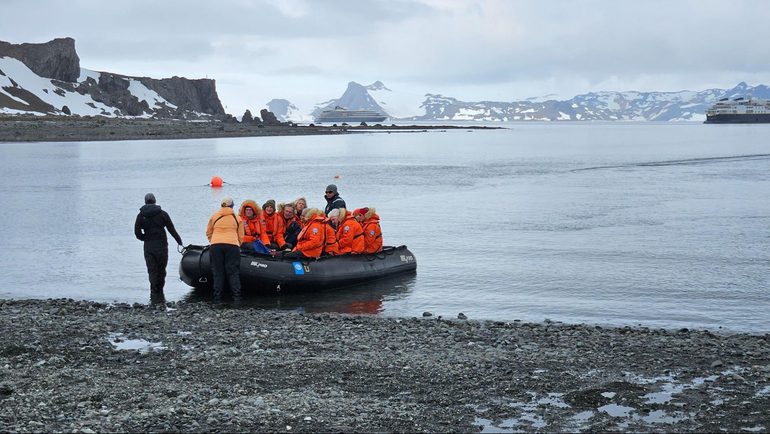
We had to step into the water and hand our luggage to crew members. (Photo by Tiffani Sherman)
Soon we were at the small terminal waiting to board the plane for the two-hour flight from King George Island to Puerto Natales, Chile.
Since flights can be unpredictable out of Antarctica and can be delayed, everyone was staying at least one night at a hotel in Puerto Natales before flying onward. Nat Geo/Lindblad representatives were at the hotel to assist with flights and transfers.
Overall impressions
Overall, I had an amazing experience on the National Geographic Explorer on my cruise with National Geographic-Lindblad to Antarctica.
While some pre-trip communications were a bit confusing, everything on the ship was just about perfect.
The ship was small but adequate, the food was good, the lectures and briefings were informative, and the excursions were incredible.
When booking a trip to Antarctica, size matters. The smaller the ship, the more you will get to experience and do.
Top photo: The National Geographic Explorer in Whalers Bay. (Photo by Tiffani Sherman)
How to maximize your rewards
You want a travel credit card that prioritizes what’s important to you. Here are some of the best travel credit cards of 2025:
Flexibility, point transfers and a large bonus: Chase Sapphire Preferred® Card
No annual fee: Wells Fargo Autograph® Card
Flat-rate travel rewards: Capital One Venture Rewards Credit Card
Bonus travel rewards and high-end perks: Chase Sapphire Reserve®
Luxury perks: American Express Platinum Card®
Business travelers: Ink Business Preferred® Credit Card





